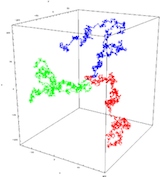Journée
FRUMAM, St Charles, Marseille
Date(s) : 31/03/2015 iCal
10 h 00 min - 17 h 00 min
Journée thématique
–
On y parlera de groupes hyperboliques, de marches aléatoires, de systèmes dynamiques stochastiques, de cohomologie, …
–
Lieu : FRUMAM (accès)
–
PROGRAMME
10h : Sara BROFFERIO
Mesures invariantes infinies pour Système Dynamique Stochastique asymptotiquement linéaire
On considère un système dynamique stochastique défini récursivement par $X_n = \Psi_n(X_{n-1})$, où les $\Psi_n$ sont des transformations continues de ${\bf R}$ choisies aléatoirement, indépendamment et avec la même loi.
Nous supposons que les fonctions $\Psi_n(x)$ soit asymptotique à une fonction linéaire $A_nx$, où $A_n$ est un nombre aléatoire positif.
Le modèle de base est le processus défini par des transformations affines $X_n = A_n X_{n-1} + B_n$, qui est strictement lié aux marches aléatoires sur le demi-plan hyperbolique.
Notre objectif est de décrire les mesures de Radon invariantes du processus $\{X_n\}$ dans le cas critique ${\bf E} \log A = 0$. et de montrer que, à l’infini, elles de comporte comme $dx/x$.
La preuve s’appuie fortement sur la théorie du renouvellement sur le demi-plan hyperbolique.
–
11h : Bertrand DEROIN
Marches aléatoires sur les groupes ordonnables et actions presque-périodiques
On s’intéressera aux marches aléatoires symétriques et à support fini sur les groupes ordonnables, et on montrera qu’elles permettent de définir des actions presque-périodiques sur la droite réelle. Nous motiverons cette étude par diverses questions concernant les groupes ordonnables.
–
– Buffet pour le déjeuner.
–
13h45 : Sébastien GOUËZEL
Entropie et vitesse de fuite dans les groupes hyperboliques
Résumé : Il y a deux manières naturelles de construire des éléments au hasard dans un groupe de type fini : on peut prendre un élément uniformément dans une grande boule, ou suivre une marche aléatoire pendant longtemps. Le premier procédé explore mieux la géométrie du groupe, tandis que le second est beaucoup moins coûteux d’un point de vue algorithmique. Il serait donc souhaitable de construire des marches aléatoires spécifiques pour lesquelles les deux procédés donnent essentiellement le même résultat. J’expliquerai pourquoi, dans les groupes hyperboliques non virtuellement libres, ce n’est jamais possible.
–
14h45 : Alessandro SISTO
Deviation estimates for random walks and acylindrically hyperbolic groups
We will consider a class of groups that includes non-elementary (relatively) hyperbolic groups, mapping class groups, many cubulated groups and C'(1/6) small cancellation groups. Their common feature is to admit an acylindrical action on some Gromov-hyperbolic space and a collection of quasi-geodesics « compatible » with such action.
As it turns out, random walks (generated by measures with exponential tail) on such groups tend to stay close to geodesics in the Cayley graph. More precisely, the probability that a given point on a random path is further away than L from a geodesic connecting the endpoints of the path decays exponentially fast in L.
This kind of estimate has applications to the rate of escape of random walks (local Lipschitz continuity in the measure) and its variance (linear upper and lower bound in the length). Joint work with Pierre Mathieu.
–
16h : Antoine GOURNAY
The reduced $\ell^p$-cohomology in degree 1 and harmonic functions
Reduced $\ell^p$-cohomology in degree 1 (for short « LpR1 ») is a useful quasi-isometry invariant of graphs [of bounded valency] whose definition is relatively simple. On a graph, there is a natural gradient operator from functions to vertices to functions on edges defined by looking at the difference of the value on the extremities of the edge. Simply put, this cohomology is the quotient of functions with gradient in $\ell^p$ (of the edges) by functions who are themselves in $\ell^p$ (of the vertices).
« LpR1 » is a form of ideal boundary, for example, for $p=1$ it identifies to functions on the ends and in the case of hyperbolic case (a result of Bourdon & Pajot) to a space of Besov functions on the boundary.
In this talk, I will explain how, under some assumptions on the isoperimetric profile one can identify « LpR1 » with a subspace of the space of bounded harmonic functions and yields some interesting corollaries on this space (for example, on lamplighter graphs). The transport cost comes up naturally as a key ingredient in the proof.
–
Organisateur :
– Pierre Mathieu (I2M, Marseille)
–
Partenaires :
– Labex Archimède
– I2M
– FRUMAM
Catégories

